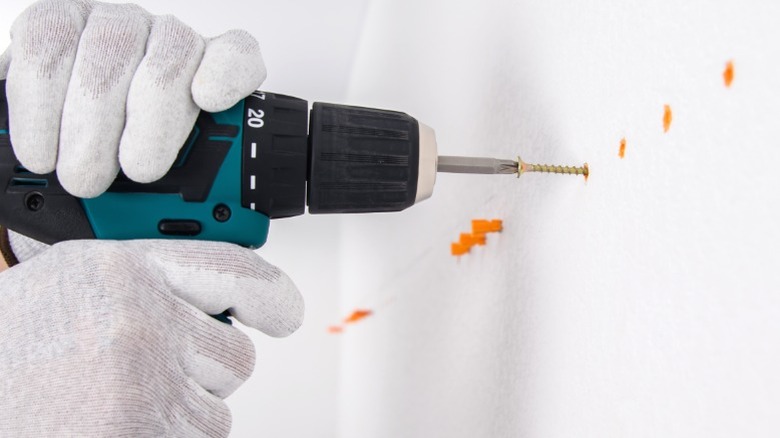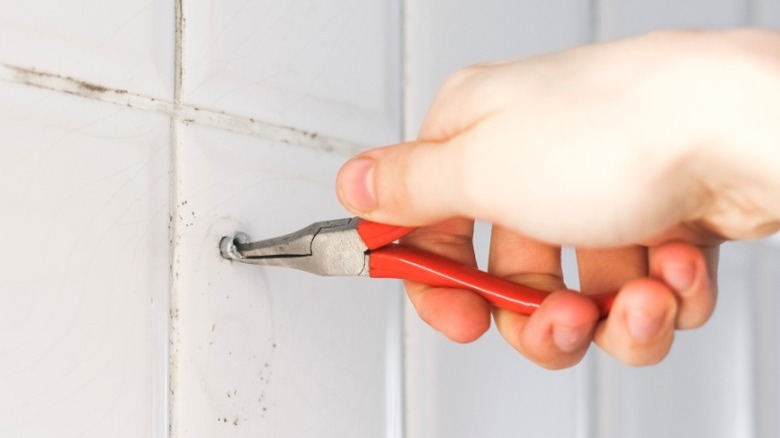Can You Reuse Drywall Anchors? It Depends On These Key Factors
At a certain point, past solutions can create new problems. After riddling your walls with holes and anchors to support a changing array of decor, you'll eventually find an old anchor sitting precisely where you need to install a new screw for your latest upgrade. So, how should you approach it? Do you remove the old anchor and insert a fresh one or save yourself the effort by simply reusing what's there? Before you decide, you have to ask whether you can reuse the drywall anchor in the first place.
Whether you want to put a new item on an old anchor or install a previously used anchor in another place, reusing wall anchors can be an appealing thought. Sure, anchors are cheap. But if you can skip the hassle of finding a new one, why not try it? When replacing fixtures in the same place, this could prevent further drywall damage as you aren't pulling out and replacing the anchor. Meanwhile, moving an old anchor with the fixture as you rearrange the space will take much of the guesswork out of finding a suitable piece.
In both cases, reusing the anchor is a conditional consideration. Some types of drywall anchors, like metal ones, are reusable. Others, such as plastic expansion anchors, only work once. Generally, you should check product labels if you want reliable multi-use anchors. Yet even then, anchors that are normally good for several uses may not work based on the circumstances. For safety and efficiency, you have to consider all the angles.
Insert new screws in old anchors
Say you're changing your decor and want to swap a framed picture for a new ornament. While you may be able to use the drywall anchor that's in place, you have to assess its condition and effectiveness for its new role. If it's installed well and not overtightened, and the screw was threaded correctly, the anchor may stand another use. The crucial step is to make sure any new screws match the diameter and threading of the original screw. Oversized screws can damage the anchor and loosen the threading's grip.
Metal anchors are more forgiving and can resist damage through multiple uses better than plastic versions. But if you use the wrong-sized screw, you likely won't be able to insert it completely. More importantly, the resistance may make the anchor twist into the drywall as you try to screw it in, stripping the hole and weakening its hold in the wall.
Beyond getting the right hardware, check the application. Different anchors have different weight ratings, and if you're changing a fixture, like upgrading a 55-inch TV to a 65-inch, you need to ensure the existing anchor can hold the new item. You may want to add more anchors to disperse the weight for assurance. In other cases, you should play it safe and get an anchor that you are certain is rated for the item you're hanging. As long as you properly use and remove the wall anchors, drywall damage will be minimal, making it more likely to accept new anchors.
Can I remove a wall anchor and reuse it in a new place?
Many anchors, such as plastic expansion and self-drilling anchors, can't survive moving to a different place, as even small amounts of warping and damage can compromise their hold. Toggle varieties and other metal anchors, by contrast, can often work reliably for more uses, particularly if the product label says so. If the threading and the sections that grip the wall are undamaged and sturdy, they should be fine. The biggest issue for many of these is extracting them from the current wall. For instance, toggle anchors can be tricky to remove intact since they're designed to fall back into the wall when you take out the screw.
Even though your anchor might be in good condition, it still may not be appropriate for your new project. Differences in aspects like wall thickness, location, and material can affect an anchor's practicality. Anchors are often only rated for certain wall thicknesses. For example, an anchor that held pictures on drywall may not work for mounting things on a hollow-core door. And when going to thicker walls, your existing toggle bolts might not have enough clearance to expand in the new space. At the same time, wall thickness can impact the anchor's weight capacity, a crucial consideration if you're moving an item to a different spot using the same anchor. An anchor may have a lower weight capacity on thinner walls, so if you move from ½-inch to ¼-inch drywall, for instance, there may be a higher likelihood of the anchor failing.


